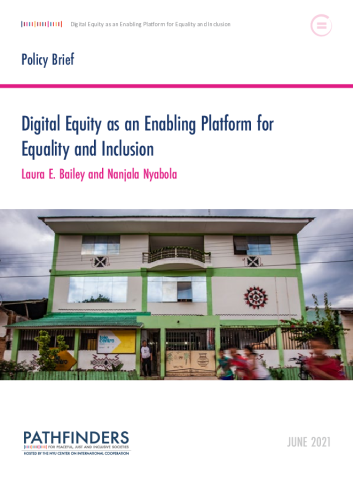A New Era In Digital Governance: The Global Digital Compact’s Blueprint For Change

Last April, following the release of the initial draft of the Global Digital Compact (GDC), we highlighted two key priorities for governments to consider during negotiations: closing the digital divide and addressing fragmentation and critical gaps in global digital governance, particularly concerning artificial intelligence (AI) and other emerging technologies.
After extensive negotiations and multiple revisions of their text, the co-facilitators of the process, the Permanent Representatives of Sweden and Zambia to the United Nations (UN), published the final version of the Compact one week ago. The document is set to be adopted by government representatives at the highest level during the upcoming Summit of the Future in New York on September 22, 2024.
The final version of the GDC marks a significant step forward in articulating concrete objectives towards bridging all digital divides between and within countries, as well as in the global governance of digital and emerging technologies, addressing many of the key issues outlined in our initial blog. While the Compact establishes a comprehensive, inclusive, and forward-looking framework with the potential to meaningfully transform digital governance, it also explicitly leaves some issues outside its scope, deferring them for future revisions. This reflects the delicate balance the co-facilitators had to strike to achieve a meaningful outcome in a highly polarized international context.
Closing the Digital Divides for All: A Concrete, Inclusive, and Realistic Path Forward
With explicit commitments such as achieving universal connectivity by 2030, mapping and connecting all schools, enhancing telemedicine services, and ensuring affordable broadband access, the intention of the final version of the Compact of closing the digital divide is not merely aspirational.
The GDC, in fact, includes concrete, measurable, and actionable commitments, such as the goal of developing innovative financing mechanisms specifically targeting the remaining 2.6 billion people still without internet access. In acknowledging the primacy of investing in digital public goods and infrastructure that is accessible to developing countries, including rural and underserved areas, it prioritizes inclusivity and accessibility. Multi-stakeholder partnerships that leverage these platforms are recognized as necessary to advance solutions towards sustainable development. Inclusivity is further enhanced by ensuring that the voices of developing countries, civil society, and the private sector remain central to the implementation process.
The Compact aims to strengthen the credibility of these goals by ensuring that experts with the necessary knowledge and mandates continue to lead in their respective fields. It acknowledges existing mandates and assigns specific roles to UN bodies, such as the International Telecommunication Union (ITU), the UN Development Programme (UNDP), and the Office of the High Commissioner for Human Rights (OHCHR). It also reaffirms the outcomes of the World Summit on the Information Society (WSIS) and endorses the ongoing role of multistakeholder platforms like the Internet Governance Forum (IGF).
Additionally, the Compact urges governments to integrate these digital strategies into national development plans and recognizes the High-Level Political Forum on Sustainable Development (HLPF) as central in monitoring progress in closing digital divides. This ensures its follow-up process will be a core component of the implementation of the 2030 Agenda.
Finally, the GDC’s emphasis on gender equality and the empowerment of women and girls in the digital space is bold and forward-thinking. By calling to incorporate a gender perspective into all digital strategies and tackling gender-based violence online, the Compact aims to bridge the gender digital divide in a manner rarely seen in global agreements on digital issues.
The proposed Compact recognizes that to achieve all these, financing is a key component that will need to be figured out. This will require the coming together of private, public, and multilateral actors to deliver financing facilities at the scale of desired impact. To this end, it calls for the use of innovative and blended financing instruments that would include the participation of the private sector and philanthropies, as well as digital-specific windows in existing frameworks such as the Digital Window of the Joint SDG Fund and other multilateral development bank instruments. This is especially crucial given the current international financial constraints.
A Groundbreaking Focus on Human Rights
One of the GDC’s most impressive elements is its unwavering commitment to human rights in the digital age. The text goes beyond mere rhetoric and establishes human rights in the digital space as central to the future of technology governance. It reaffirms international human rights law as the bedrock of digital cooperation, with specific commitments to protecting and empowering those in vulnerable situations, combating online harms like hate speech, and preventing digital rights abuses.
This represents a significant advancement, as the adoption of the GDC will see representatives at the highest level of government formally recognize the escalating threats digital technologies pose to civil and political rights, both online and offline.
The GDC also confronts many other challenging issues head-on with a rights-based approach. It acknowledges the risks associated with emerging technologies, commits to ensuring human oversight and robust safeguards to protect against online abuses, and requires governments to pledge against internet shutdowns and preserve digital privacy.
Balancing Global Cooperation with National Sovereignty in Digital Governance
During the negotiations, delegations often clashed over sensitive issues, expressing opposing views on cross-border data flows, the military use of digital technologies, the protection of human rights—ranging from the right to privacy to freedom of expression—and the participation of non-state actors.
In a highly polarized and politicized international environment, it seemed inevitable that the Compact, while promoting greater international cooperation, would also need to include safeguards to protect the role of national governments in digital policy decision-making.
As a result, the final draft not only advocates for global governance and multistakeholder collaboration but also acknowledges the importance of national priorities, legal frameworks, and the ultimate role of governments in shaping the future of digital governance. The GDC also underscores that its implementation will respect national realities, capacities, and priorities.
For instance, in its commitment to enhancing digital public infrastructure, the Compact acknowledges that different societies will develop and utilize shared digital systems based on their unique needs and priorities. This flexible approach ensures that no single global model is applied to all countries, avoiding an imposition of Global North’s priorities on developing countries. In the case of cross-border data flows, the GDC advocates for the development of interoperable frameworks while recognizing the need for countries to protect privacy, data security, and human rights in compliance with their own national legal frameworks.
Enhanced Global Governance: A Strategic Framework for Coordination
In its final sections, the Compact tackles the existing fragmentation in global digital governance, establishing a more streamlined and coordinated global governance system for digital technologies.
With almost 30 UN-related bodies already working on digital matters, the proposed GDC leans towards a soft model of cooperation and coordination. At the same time, the Compact calls for integrating existing platforms and emphasizes the importance of promoting multi-stakeholder involvement, which is essential for reducing duplication and ensuring an inclusive approach.
Perhaps one of the most progressive aspects of the GDC is its commitment to AI governance from a universal, regionally balanced, and scientific perspective. The establishment of a multi-disciplinary Independent International Scientific Panel on AI and a Global Dialogue on AI Governance are pioneering steps. While ensuring strong governmental involvement in setting up both initiatives, with a defined mandate for the President of the General Assembly to lead on the modalities, these proposals could provide evidence-based assessments of AI’s risks and benefits and create political space for all countries to express their views and positions.
The final version of the Compact, in fact, seems to try to ensure that developing countries have a voice and the capacity to develop and govern AI systems, a critical factor for achieving equitable global development. This proactive stance on AI governance could become a true game-changer, positioning the UN as the key player in shaping global AI rules.
Finally, the inclusion of a follow-up mechanism embedded in the UN General Assembly and the request for the Secretary-General to submit a proposal for the creation of a new office with a mandate to facilitate system-wide coordination are additional welcome outcomes. These mechanisms could ensure that progress on digital governance is continuously monitored, that developing countries are meaningfully represented in the process and that the UN system operates with more articulated and centralized coordination.
In this regard, the GDC has the potential to pave the way for a new model of inclusive global governance, rooted in the universality of the UN General Assembly, agile enough to adapt to rapid technological advancements and ensure no one is left behind. It sets the stage for a new era of international cooperation and collective action, leaving the door open to continue improving a well-rounded and robust framework that empowers all countries and stakeholders to navigate the complexities of digital governance. Far from being a missed opportunity, the GDC provides a delicately negotiated platform for future progress with the minimum safeguards demanded by some governments to ensure their final endorsement.
Read More
-
-

Digital Equity as an Enabling Platform for Equality and Inclusion
The global pandemic has laid bare the digital inequities across vertical (income) and horizontal (social, political, and identity) dimensions, while exposing the extent to which pre-pandemic approaches to bridging the digital divide have been dominated by economic considerations even while they are not universally treated as policy priorities. This brief reviews key aspects of the digital divide, with special attention to exclusion and inequality, emphasizing that poor connectivity isn’t just about wealth—it is also about inequality.
Stay Connected
Subscribe to our newsletter and receive regular updates on our latest events, analysis, and resources.
"*" indicates required fields



